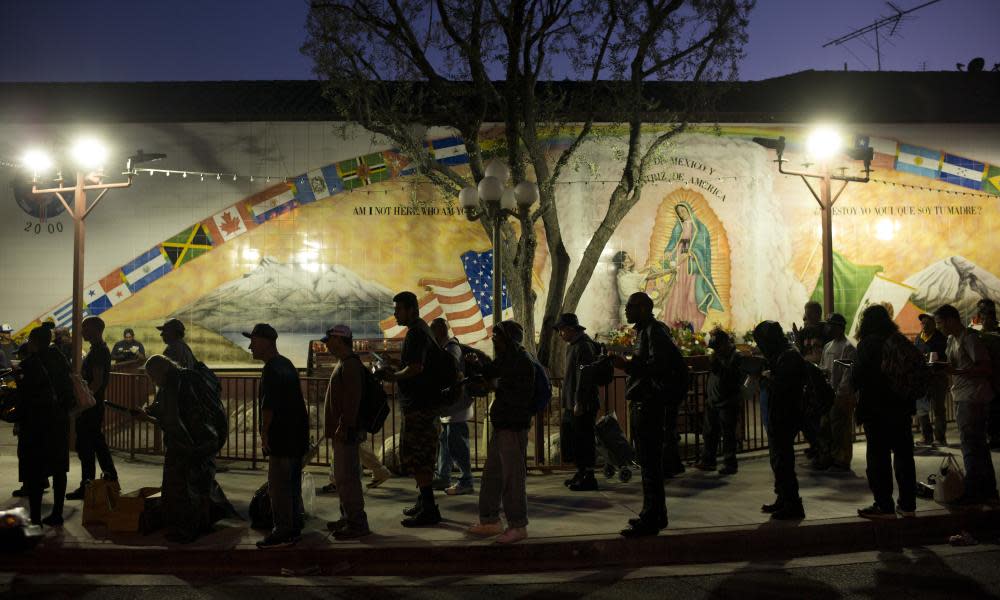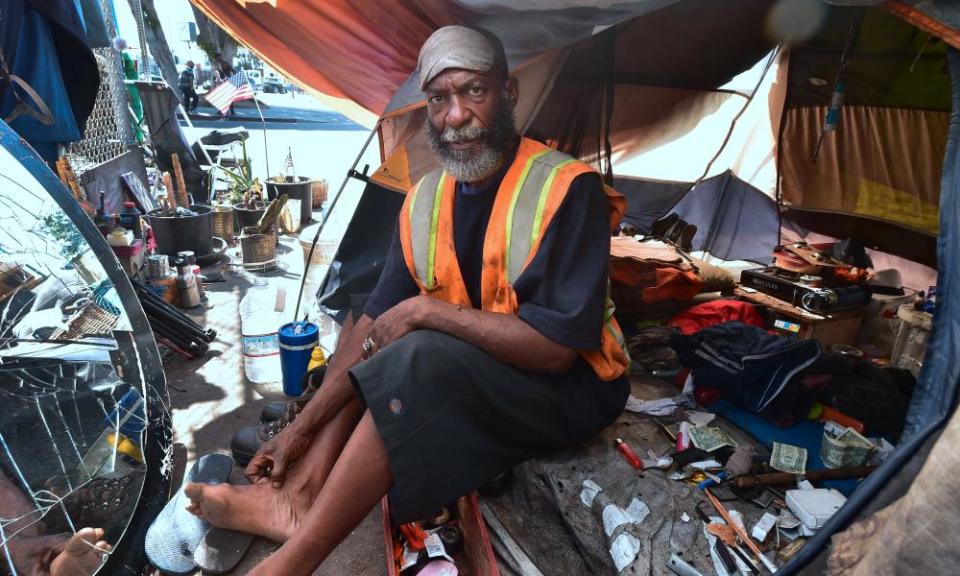'America's new Vietnam': why a homelessness crisis seems unsolvable

In Los Angeles, the more the politicians push to solve the city’s festering homelessness crisis, the worse it seems to get.
The city leadership has taken one bold step after another: restructuring the budget to free more than $100m a year in homelessness funding, sponsoring one voter-approved initiative to raise more than $1bn for housing and backing another regional proposal to raise the sales tax and generate an estimated $3.5bn for support services over the next decade. And yet the tent cities continue to proliferate, in rich neighborhoods and poor, by the beach, the airport, the Hollywood Walk of Fame and within view of City Hall itself.
It’s the sorriest urban scene anywhere in America, and the same voters who not so long ago opened their hearts and their wallets to put an end to it are growing increasingly impatient. As the numbers of homeless people continue to rise – the latest figures put the countywide number at 58,000, up more than 20% in a single year – and new encampments spring up on sidewalks, under freeways, and along stretches of river and rail lines, the politicians who not so long ago were earning praise for their courage are facing the beginnings of an angry backlash.
“How many people have we housed?” the Los Angeles Times asked impatiently in a blistering series of editorials late last month. “How many are we on track toward housing? Is Los Angeles setting the national standard for rapid and effective response to a vexing problem? Or are its leaders merely mastering the art of appearances while passing the buck and hoping things turn around? … Who’s in charge here?”
Most infuriating, to the Times and to many others, has been the reluctance of many LA city council members to move forward on supportive-housing projects. More than a year after the money became available, just two of the first 10 sites identified as easiest to build quickly have broken ground, leaving the others hostage to neighborhood groups anxious about having people with addiction and mental health problems move in next door.
The politicians are clearly feeling the heat from the Times series. Two city council members responded by announcing they were pushing ahead with housing projects they’d previously blocked.
It’s not clear, though, whether the politicians entirely deserve the opprobrium, or if it just seems that progress has stalled because the problem continues to grow for reasons beyond their control.
Greg Spiegel, who served as Mayor Eric Garcetti’s homelessness coordinator and now works for a not-for-profit organization providing legal services to the poor and homeless, sees the crisis as so complex and intractable – the result of decades of national and local housing policies, as well as broader macroeconomic trends – that he called it America’s new Vietnam, and tackling it an act of moral bravery but, perhaps, of political folly.
Despite appearances, recent efforts utilizing existing housing stock have in fact made a big difference. “We saw 14 or 15,000 people permanently housed last year,” Spiegel said. “That’s a lot of people, more than ever before, triple what it was three or four years ago.”
And since a sales-tax boost went into effect, the number of social workers, mental health specialists and others working directly with people on the streets has quadrupled across the county, according to Alisa Orduna, the homelessness coordinator for Santa Monica.
“When you see someone yelling outside a 7-Eleven in your neighborhood, you can have a much higher degree of confidence now that that person is on someone’s radar, which is the first step toward getting them off the street,” she said.
Orduna likened the region’s response to homelessness to the national response to the Aids crisis in the 1980s. The effort entails building a whole new infrastructure from scratch – one that involves churches, private businesses, not-for-profit groups and individual volunteers as well as government agencies.
For example, Methodist churches across South LA, one of the city’s poorest neighborhoods, are looking for ways to use their land and buildings for housing. A church in Santa Monica recently opened up housing units for homeless college students.

The crisis, however, is galloping ahead of such initiatives. Los Angeles has a 2% vacancy rate, which is causing rents to soar and creating a whole new pool of people who are just one medical emergency or job loss away from becoming homeless themselves.
“We have got to make it easier, less costly and faster to build housing of all types in Los Angeles,” said Michael Lens, a housing policy specialist and professor of urban planning at the University of California, Los Angeles. Politicians are only part of the problem, he said. He also sees a pervasive attitude, especially among older Angelenos, that this should be a city predominantly of single-family homes and that creating greater urban density is somehow a betrayal of the city’s essence.
That culture is now changing – as evidenced by the revival of downtown Los Angeles over the past two decades as a place to live as well as work, and the flourishing of many other previously car-centric neighborhoods.
In government circles, experts are trying hard to break old molds and create new lines of authority. One idea, for example, is to allow the county homeless services agency to decide where to build housing, so local politicians don’t have to take so much heat from nimby-ish residents’ associations.
Another idea is to rewrite the city’s longstanding rent control rules, which tend to fail landlords and tenants alike. A third is to make building regulations less rigid so, for example, lower-income apartment blocks are not required to include a parking space for every unit.
The problem for elected officials is that such changes come slowly and out of the public eye, while the evidence of crisis on the streets remains all too palpable. That’s a particularly thorny problem for Garcetti, who is considering a run for president in 2020 and can expect to see footage of the human misery outside City Hall endlessly replayed in his rivals’ political ads.
Many homelessness experts said it was understandable that people would rush to harsh judgments, but politicians should get credit for the steady if unspectacular progress.
“The city can work on land use policy and housing construction, but a lot of what it does is a response to a broader crisis that it doesn’t have the tools to solve,” said Spiegel. “Homelessness is a symbol of the failures of all our institutions.”

 Yahoo News
Yahoo News 
